|
|
|
|
| Home > Reviews > 1/48 Scale > MR Modellbau 1/48 scale Sturmgeschütz III Field Modifications (4834) |
Sturmgeschütz III Field Modifications
MR Models, 1/48 scale
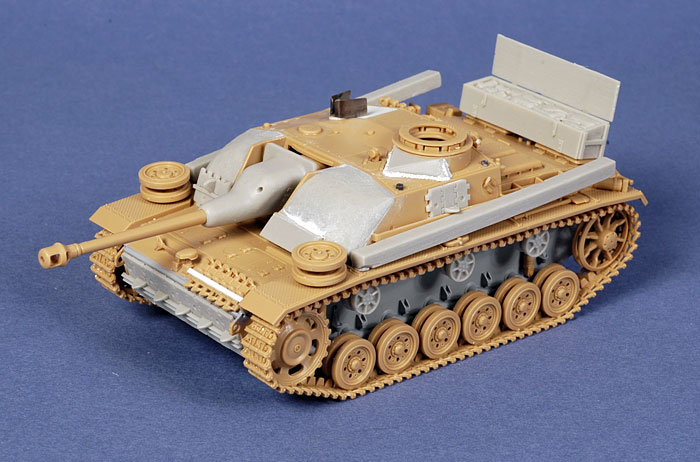
| Catalogue Number and Description: | MR Modellbau item no. 4834 - Rüstsatz Sturmgeschütz III (Sturmgeschütz III Field Modifications) |
| Contents and Media: | 11 parts in grey resin |
| Scale: | 1/48 |
| Price: |
€11.50 available online from MR Modellbau website €12.12 available online from Quarter Kit's website |
| Review Type: | FirstLook |
| Advantages: | Interesting selection of variations and field modifications for the Tamiya 1/48 scale Stug III Ausf.G; very useful for late and Finnish versions; very high quality casting with minimal pin holes or other imperfections. |
| Disadvantages: | Some experience required to prepare and install the parts. |
| Recommendation: | Highly Recommended |
FirstLook
Although Panther and Tiger tanks tend to dominate the spotlight, the mainstay of Germany's WWII armoured force were more modest vehicles. The Panzer III, Panzer IV and Sturmgeschutz III bore the brunt of fighting.
The Sturmgeschutz III was originally conceived as a close-support and mechanised artillery vehicle but it swiftly migrated toward the anti-tank role following its introduction in 1940. In line with the general trend toward heavier armour and armament, the StuG III was up-gunned. The Sturmgeschutz III Ausf. G was armed with the long barreled 75mm StuK 40 L/48. This was an excellent anti-tank weapon, capable of penetrating all but the heaviest Soviet armour.
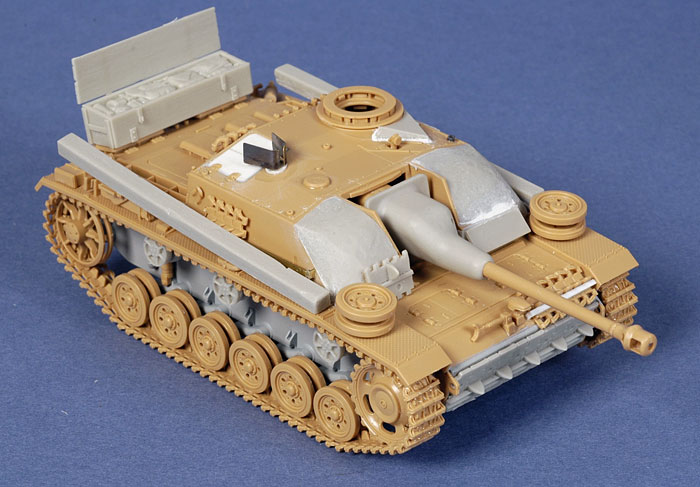
Development of the StuG III Ausf.G continued, both in the factory and in the field, until the last months of the war. The constant quest for improved protection led to many improvised solutions, including track links or logs as appliqué armour, concrete and steel additions to the superstructure, and new defensive measures including a co-axial machine gun, a remote controlled machine gun and a close defence weapon on the superstructure roof.
MR Model now gives 1/48 scale modellers the opportunity to depict some of these modifications.
MR's 1/48 scale Sturmgeschütz III Field Modifications set comprises 11 pieces in in grey coloured resin plus a replacement turned metal gun barrel.
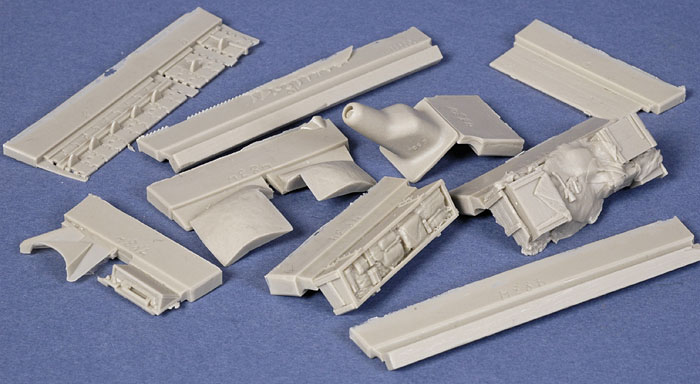
The parts include two styles of stowage box for the rear hull (one with a separate cover); concrete armour for the front of the superstructure, armoured cover for the driver's visor; shot deflector for the Commander's cupola, T-34 track links as additional armour( three separate sections); Saukopf mantelet and two unditching beams.
Most of these features were seen on late-war StuGs.
Both stowage boxes are very well done, being packed with contents. You will be able to use these on two different vehicles, as they both mount on the rear of the engine deck.
The concrete armour looks good too, with appropriate surface texture.
The T-34 track links are supplied in one long run for the lower hull front , a section of two tracks on the front of the superstructure (both these pieces are cast with a mounting rack in place) and three track links for general placement on the vehicle.
The untrenching beams are square in profile. These beams were sometimes carried on the track guards of StuGs.
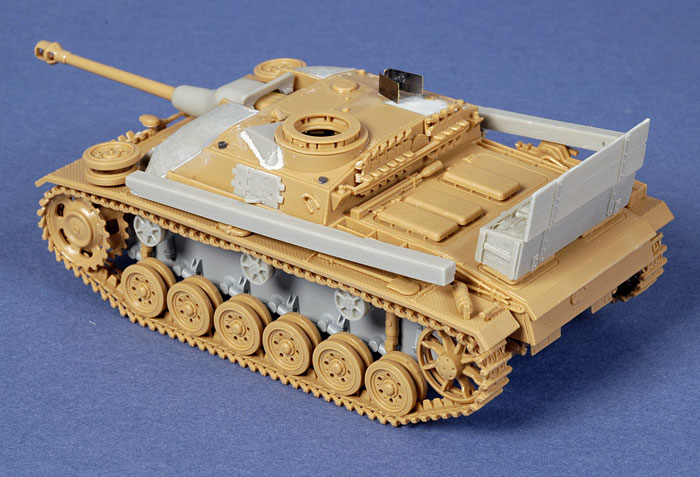
Tamiya's late StuG IIIG kit already includes a shot deflector and Saukopf mantelet, but the equivalent resin conversion parts are still useful. The shot deflector appears to represent the steel version produced in the factory, while Tamiya's part seems to be the steel and concrete field mod. The resin Saukopf is nice too, with authentic texture and casting numbers on the port side.
In addition to German vehicles, this set will be applicable to a number of Finnish StuG III Ausf Gs (Stu-40 or Sturmi) which featured concrete armour, driver's visor and untrenching beams.
Casting quality is very good, with only a few tiny pin holes in my sample.
There is a list of parts and two photos of the assembled model with the resin parts labeled and shown in place. Assembly is quite straightforward after the parts have been removed from their casting blocks.
Fit of the parts was generally very good. I drilled right through the Saukopf mantelet, allowing the kit gun barrel to pass through the mantelet and mount in the breech.
The concrete armour needed a few rounds of test fitting and trimming, but the final result was minimal filling with Milliput on the lower sides and above the driver's visor.
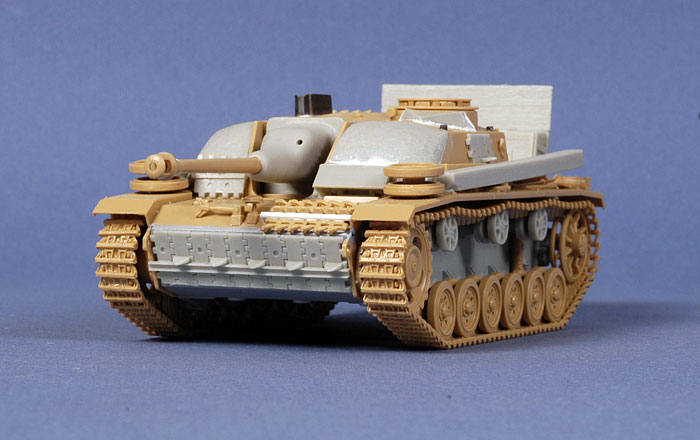
In addition to useing MR's parts, I decided to convert my Tamiya Stug III to a late Ausf.G as follows:
-
removed the base for the original machine gun shield from superstructure roof
-
sliced hinges for loader's hatch from roof and hatch
-
scratch built new loader's hatch (side opening) from plastic card using two of the hinges retrieved from the old hatch. I have yet to find two more hinges for the other side!
-
scratch built remote control machine gun base and guard from punched plastic disks and thin metal sheet
-
relocated two Pilsen crane mounts on roof and added a further two from fine plastic tube
-
the cover for the close defence weapon and the late-style gun cradle, both supplied in the kit but marked "not for use", were installed
-
drilled hole for co-axial machine gun in resin Saukopf mantelet
-
relocated spare wheels to front trackguards
-
used late-style steel return rollers from MR Modellbau's set number 4835
-
additional racks for spare track links were fabricated from plastic and brass strip. The kit track holder from the front hull was adapted (shortened) for the side of the superstructure
-
I also added a weld bead to the base and rear of the Commander's shot deflector.
Please note that these conversion items are not compulsory for the parts in MR's Rustatz set, but my choice for a very late production vehicle.
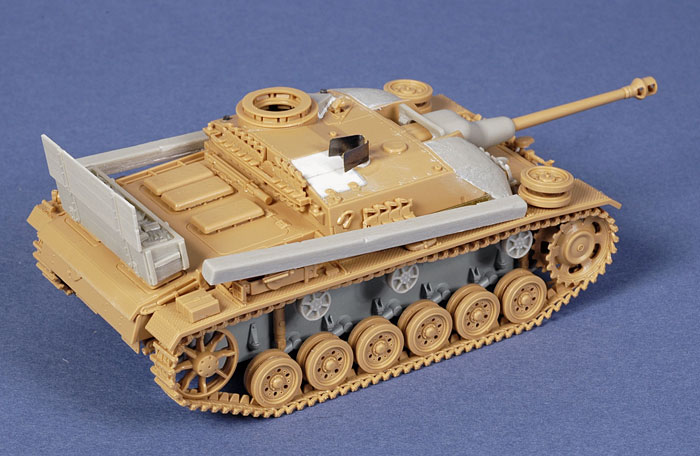
Congratulations to MR for continuing to produce interesting and high quality conversions for armour models in this emerging scale.
Highly Recommended.
Thanks to Frank Berger and MR Modellbau for the samples
Text and Images by Brett Green
Page Created 22 July, 2007
Page Last Updated
22 July, 2007
